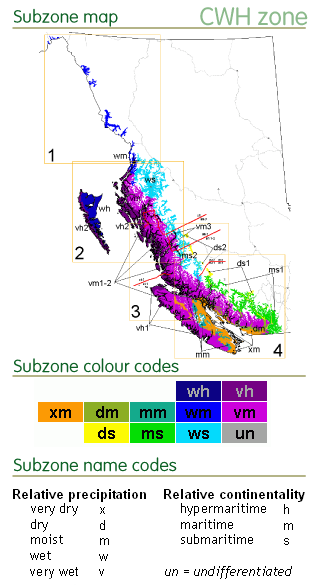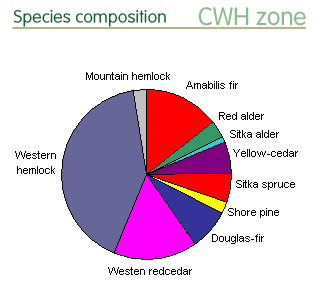Coastal Western Hemlock Zone
General description
The CWH zone occurs at low to mid-elevations along much of the coast of BC, covering 10.8 million ha or 11.4% of the province. Except along major river valleys it is found mostly west of the Coast Mountains. At higher elevations it is bordered by the Mountain Hemlock zone, and in southern coastal BC by the Coastal Douglas-fir zone.
The zone has 10 subzones which vary in precipitation and continentality. Continentality increases with distance from the ocean: hypermaritime subzones occur on the coast, maritime subzones further inland, and submaritime on the leeward side of the Coast Mountains. The wetter subzones occur on the coast and the drier ones in the rain shadows of the Olympic, Insular and Coast Mountains.
In general the climate in the CWH zone is moderate (cool mesothermal). The summers are cool and the winters mild. Mean annual temperature is 5.5°C, ranging from 2.4°C in the CWH ws2 (a northern, interior, montane subzone) to 9.3°C in the CWHxm1 (a southern, coastal subzone). The CWH is the wettest zone in BC with a mean annual precipitation of 2200 mm. Precipitation ranges from 1200mm in the CWHds2 (a central, inland variant) to 3300mm in the CWHvh2 (a northern, coastal variant).
View detailed subzone maps and climate data for the CWH zone.
Forest description
 Highly productive and structural complex coniferous forests are characteristic in this wet and mild climate. Wind is the common form of natural disturbance and compared to fire, generally only affects single trees or small patches of forest. As a result most of the forests are old; only the MH zone has a higher proportion of older forests. Western hemlock is the most common tree species and together with western redcedar is generally frequent throughout the zone. The cover of the other major species generally varies with climate (e.g. Douglas-fir is more prevalent in the drier and warmer subzones; Amabilis fir in the wetter and cooler subzones with higher elevation or latitude; yellow-cedar in the wetter, hypermaritime and maritime subzones), local conditions (e.g. shore pine on very dry or wet sites, alders on disturbed sites, cottonwood on floodplains) or both (e.g. Sitka spruce is common on a variety of sites in the north but less frequent and restricted to floodplains and beaches in the south). Species such as white pine, grand fir and bigleaf maple are considered minor species at the zone level (i.e. do not register on the zone pie chart) as they only occur in a limited number of the warmer and drier southern subzones.
Highly productive and structural complex coniferous forests are characteristic in this wet and mild climate. Wind is the common form of natural disturbance and compared to fire, generally only affects single trees or small patches of forest. As a result most of the forests are old; only the MH zone has a higher proportion of older forests. Western hemlock is the most common tree species and together with western redcedar is generally frequent throughout the zone. The cover of the other major species generally varies with climate (e.g. Douglas-fir is more prevalent in the drier and warmer subzones; Amabilis fir in the wetter and cooler subzones with higher elevation or latitude; yellow-cedar in the wetter, hypermaritime and maritime subzones), local conditions (e.g. shore pine on very dry or wet sites, alders on disturbed sites, cottonwood on floodplains) or both (e.g. Sitka spruce is common on a variety of sites in the north but less frequent and restricted to floodplains and beaches in the south). Species such as white pine, grand fir and bigleaf maple are considered minor species at the zone level (i.e. do not register on the zone pie chart) as they only occur in a limited number of the warmer and drier southern subzones.
To see how species composition in the CWH zone varies with climate, view species by subzone pie charts.
Conservation status
Protected areas
The CWH zone has more than 300 protected areas, and prior to the protected area expansion on the north and central coast, 12% of the CWH zone was protected. More than half of the protected areas are large and well distributed among and within the subzone/variants. The exception is the CWHmm1/2 with only two, large, centrally located reserves in very close proximity.
In terms of the proportion of land protected, six of the 13 subzone/variant units are under-represented and have less than 10% protected area coverage. Some of these units (e.g. xm1, xm2, dm, vm) have relatively high levels of disturbance due to settlement and/or forest harvesting. Units with representative levels of protection (10–15%) vary from relatively undisturbed (vh2) to disturbed (mm1/ mm2, ds1/ds2, ms1/ms2). The highest protected area coverage is found in the relatively undisturbed vm3, vh1, wh1/wh2 units.
- View protected area distribution on the subzone maps and the protected area and land use statistics for the subzone/variants of the CWH zone.
Species representation in protected areas
Most of the species in the CWH zone are expected to be well represented in protected areas. Of the seven under protected species, four are considered conservation concerns in the CWH zone. Arbutus and Cascara are narrowly distributed species that have a significant portion of their provincial ranges in the CWH zone. Since they are also under protected in the CDF zone, field verification of population sizes is recommended in CWH zone, especially for Arbutus, which has the potential to increase with climate warming. In contrast, hazelnut, trembling aspen, Bebb’s willow, Scouler’s willow, and hawthorn only have a minor presence in the CWH zone and are not expected to increase with climate warming. Further, their protection is predicted (for all except hawthorn) in the IDF portions of several large, multi-zone protected areas spanning the transition from maritime to continental climates. In terms of conservation genetics, only the rare clonal stands of trembling aspen in the Fraser Valley are of primary concern. Field verification is only recommended for hawthorn as it is not expected to occur at threshold values in the protected areas of the CDF zone, the CWH zone, or in the IDF portions of multi-zone protected areas spanning the CWH zone.
- See “BC Tree Species Reports” webpages to view tree species range maps with protected areas, or range maps with conservation statistics by BGC zones.
Conservation priorities
Many of the species with low protection levels in the CWH zone occur with highest frequency in the drier and milder subzones or variants (xm1, xm2, dm, ds1, ds2). These units tend to have the high levels of disturbance and the lowest protected area coverage. Increasing protected areas coverage on suitable sites in the xm1, xm2, and dm subzones and variants could potentially increase protection for Arbutus, Cascara, trembling aspen, and hawthorn. In the case of hawthorn, it is recommended that its presence be verified in the small protected areas (i.e., those not considered in this analysis), on private lands with a conservation objective, and in regional/district/city parks or recreational areas with suitable habitats.
References
The general ecology information presented here has been summarized from the BC MOF brochure on the BWBS zone and the BC MOF publication Meidinger, D. and J. Pojar. 1991. Ecosystems of British Columbia. BC Ministry of Forests, Victoria, BC. 330pp.
The in situ conservation statisitics are from Hamann, A., Smets, P., Aitken, S. N. and Yanchuk, A. D. 2005. An ecogeographic framework for in situ conservation of forest trees in British Columbia. Can. J. For. Res. 35:2553-2561. View online resources.
The in situ conservation status summaries are from C. Chourmouzis, A.D. Yanchuk, A. Hamann, P. Smets, and S.N. Aitken. 2009. Forest Tree Genetic Conservation Status Report 1: In situ conservation status of all indigenous BC species. Centre for Forest Conservation Genetics, Forest Genetics Council of BC, and BC Ministry of Forests and Range, Forest Science Program, Victoria, BC Technical Report 053. www.for.gov.bc.ca/hfd/pubs/Docs/Tr/Tr053.htm. View online resources.
